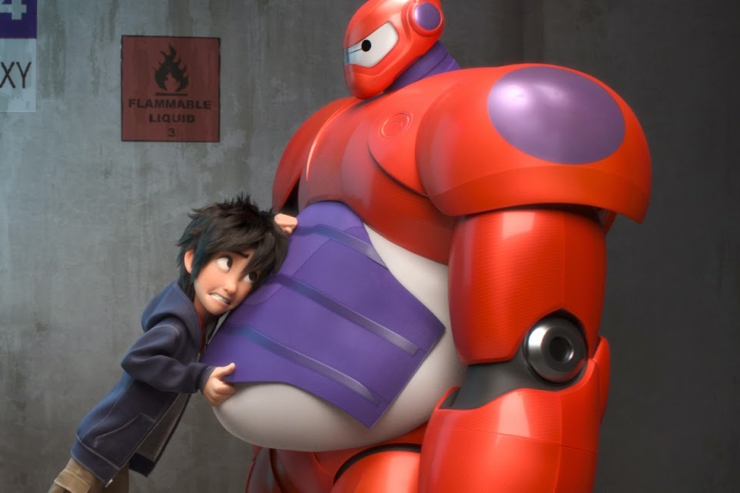The primary theme of Disney’s latest film Big Hero 6 is loss. There’s a lot to like about the film, including the honesty with which it confronts the subject of bereavement in the context of a children’s film. That’s why it’s so disappointing when in the end it undermines its own lessons and sucks the power out of its message.

Hiro Hamada and his older brother Tadashi are orphans who have grown up living with their aunt. Both experts in robotics, Tadashi creates a cuddly robot named Baymax, a personal medical assistant capable of diagnosing and treating many basic injuries and ailments, while Hiro spends his nights hustling underground robot fighting rings. Tadashi convinces Hiro to start taking life seriously, and to apply to the robotics university where Tadashi himself is a student. But when Tadashi dies in an accident, Hiro spirals into despair and depression, unwilling to begin his studies, to leave his darkened bedroom, or even to eat.
Though unable to come to terms with the loss of his brother (on top of losing his parents when he was a child), Hiro rediscovers Baymax who attempts to treat Hiro’s depression as a clinical condition, by forcing him to acknowledge friends, to embrace a reason to keep living and working, and to recognise that – through Baymax – Tadashi’s legacy lives on.

Hiro picks himself out of his lethargy when he and Baymax encounter a villain wielding an army of destructive micro-bots. Hiro outfits the soft and pliable Baymax with armour and weapons, and converts himself and his friends into a troupe of cybernetic superheroes.
It turns out that the villain has also been struggling with loss, since losing his daughter in a teleportation experiment. While Hiro’s loss eventually drove him to excel, the villain’s loss filled a once good-natured man with anger and vengeance.
Up until this point, I thoroughly enjoyed Big Hero 6’s take on loss, examining it from a child’s perspective and a parent’s perspective, and noting the extreme differences in how people can deal with what can seemingly be a senseless and hopeless occasion.

Unfortunately, in its third act, Big Hero 6 undoes a lot of its good work. In a final confrontation between our heroes and the villain, Baymax sacrifices himself to save Hiro from danger, along with rescuing the villain’s daughter (who had not died, but was merely suspended in another dimension). Following this, Hiro is able to restore Baymax from his memory chip, and they are reunited. If Big Hero 6 is all about teaching its characters how to deal with loss, then the final scenes unteach them.
The villain does not have to come to terms with losing his daughter; his daughter is restored to him. Hiro does not have to learn to live without Baymax; he is rebuilt and returned to him, to be forever a crutch for Hiro to lean on. Not only do these events rob the characters of the opportunity to learn and show growth, but they positively teach the film’s mostly young audience the wrong lesson: that at least 50% of the time human loss can be reversed and you won’t have to deal with it properly. How much more effective would the film’s ending have been if Baymax had not been restored, but Hiro dealt with the loss better than he did when Tadashi died?
By way of comparison, let’s look at one of my favourite recent animated films: How To Train Your Dragon. Both Toothless the dragon and Hiccup the failed Viking suffer personal loss in the form of injury and disability; but both become inter-dependent in beautiful symbiosis that helps them deal with their loss in a positive, relational way. The loss is not magically undone, and the characters are stronger for it.

Apart from this rare thematic misstep from Disney, I mostly enjoyed Big Hero 6. Hiro’s friends come across as a bit useless in superhero form, and could probably have been condensed into a single aggregate character; and Baymax himself would have been improved by having some dependency on Hiro. But the art and animation are stunning, the action is thrilling, the dialogue is sharp, the misdirection as to the villain’s identity is neatly subversive, and Baymax is utterly loveable.
On almost every objective measure of filmmaking, Big Hero 6 is a success. But I have trouble recommending it, since it seems to say quite wrongheaded things about death and how to live with it.


FYI the move was made by Disney Animation studios, not PIXAR… please edit your post.
LikeLike
Thanks, you’re right, of course. I’ve edited the post.
LikeLike
DONT COMPARE BIG HERO SIX TO STUPID HTTYD!! HIRO IS MY BAE
LikeLike
Quite honestly I loved how Abigail and Baymax came back at the end. I understand where you’re coming from, but at the same time this movie is geared towards, not only a wider older audience, but for children. As much as it should “teach” a lesson on loss, I think it would be much too heavy if the entire movie is about losing things and finding ways to cope with it. I found the balance to be quite ideal in this film.
Abigail coming back is a whole different lesson, where it shows how strong Hiro’s become. He could easily choose Baymax over the daughter of the man who took everything away from him; it would even feel good as revenge, but he overcomes this. Abigail is her own person, and Hiro was mature enough to realize it.
LikeLiked by 1 person
Thanks for your comment. You make some good points. 🙂
LikeLike
Baymax didn’t return right away, though. Before Baymax’s return we see Hiro moving on with his life and coping with losing Baymax, for what he believed was permanent. He was able to recover from losing Baymax better than he did with Tadashi. Only after this has been shown, is it revealed Baymax can return.
LikeLiked by 1 person